On the original Kids WB roster, Pinky and the Brain co-starred with Animaniacs and had a more mature vibe than its parent show. The worst time to air Pinky and the Brain was at 7pm on Sundays, when it had to compete with 60 Minutes and a tonne of football games.
It was not a good time during primetime. When compared to controlling the entire world, that is not much. Two genetically modified mice named Pinky and the Brain, who first made an appearance in a recurring one-act episode of the original Animaniacs, were granted their own show in 1995.
While the genetically modified lab mice have had their own television programme for 25 years, Pinky and the Brain debuted on Animaniacs 27 years ago. The show was discontinued because the WB station did not know what to do with it.
What The Cartoon Television Series Is All About
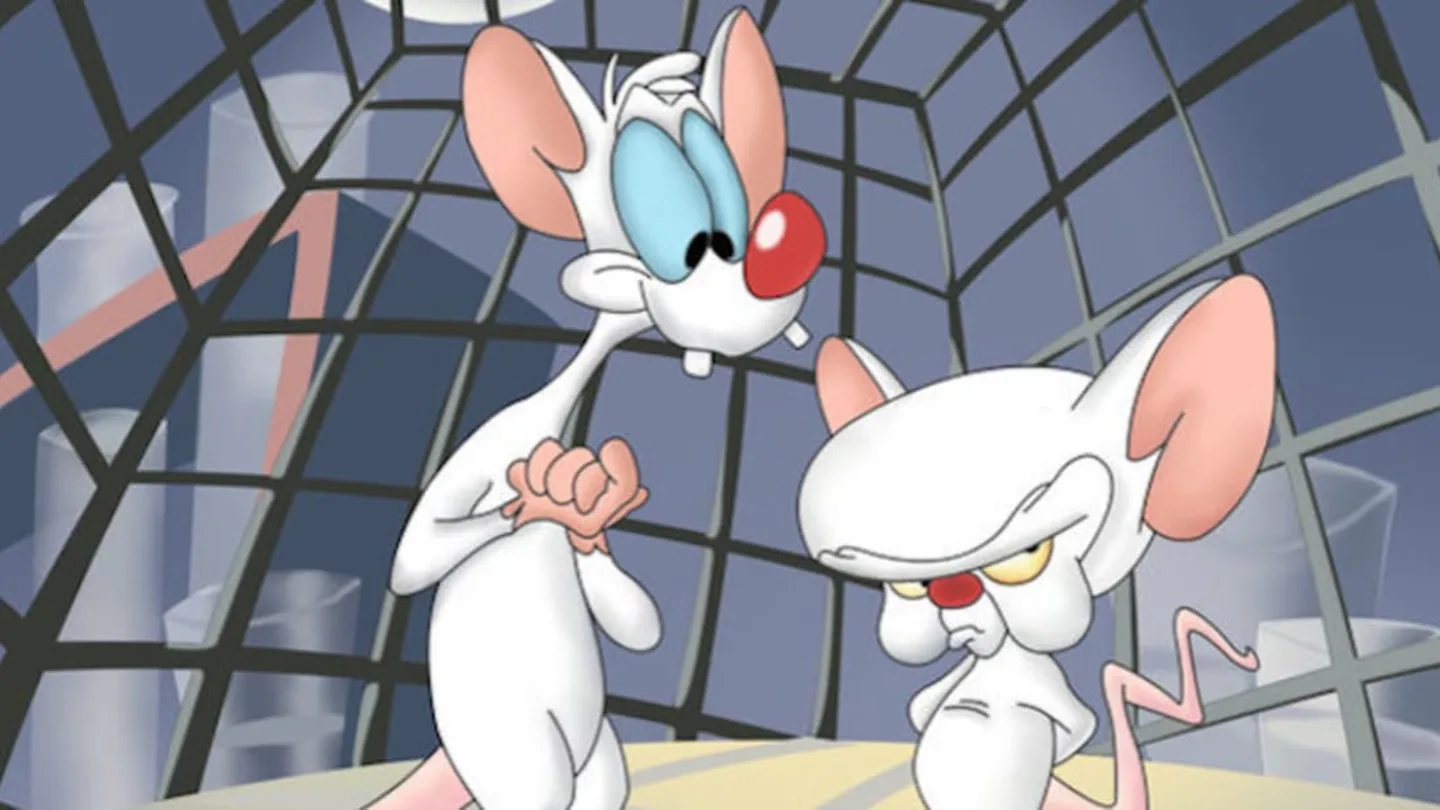
Tom Ruegger created the American animated television program Pinky and the Brain, which debuted on Kids’ WB on September 9th, 1995. It was Steven Spielberg’s fourth collaboration with Warner Bros. Animation and his production company, Amblin Entertainment, as well as the first animated television programme to be broadcast in Dolby Surround. The characters first appeared in 1993 as a running joke on Animaniacs. Due to its overwhelming popularity, it was subsequently turned into a television series, with sixty-six episodes produced. The main characters later made their television debuts in Pinky, Elmyra & the Brain, and most recently returned to their Animaniacs roots in the 2020 revival of that series.
Pinky and the Brain, who reside in a cage at Acme Labs, are actually genetically altered research mice. Pinky is highly friendly and upbeat but dim-witted, whereas Brain is exceedingly shrewd, egotistical, and cunning. Every episode, Brain devises a new plan to take control of the world, which usually fails due to the complexity of his plan, his own arrogance, Pinky’s mistakes, an oversight on his side, uncontrollable occurrences, or some combination of these factors. Like so many other Animaniacs works, many episodes parody another work, usually a movie or book.
Acme Labs, which is situated beneath a suspension bridge in one of the major American cities, is where a large number of Pinky and the Brain episodes were filmed in the 1990s. Numerous episodes include Pinky and Brain visiting the research facilities of various scientists, including Merlin, Ivan Pavlov, Johannes Gutenberg, and H.G. Wells. There is not much continuity between episodes aside from the two mice’s shared traits, though some early ideas for dominating the world are later hinted at in later seasons. For instance, Brain’s mechanical human suit, first seen in “Win Big,” reappears when Brain battles his foe Snowball in the episode “Snowball.”
With a few exceptions, the majority of each episode revolves around one of Brain’s plots for world dominance and its final failure. One focuses on Snowball’s plot to use Microsponge to take over the globe, which is a spoof of Microsoft. Another episode depicts Brain’s one-day attempt to do anything other than take over the globe: in the conclusion, a bunch of people vote that he should rule over the globe on the only day he does not want to.
Pinky and Brain, two white-colored lab mice maintained as a component of Acme Labs’ experimental research, have undergone substantial genetic alteration, as stated in the show’s main lyrical content, “their genes have been spliced,” giving the two mice enhanced intellectual ability over that of a standard mouse, the ability to communicate with humans, and anthropomorphism.
According to “Project B.R.A.I.N.,” the gene splicing happened on 9th September in 1995, which coincides with the first full segment of Pinky and the Brain. According to the episode “Brainwashed,” Dr. Mordough, together with a hamster named Snowball and a cat named Precious, used the Bagel Warmer, Acme Gene Splicer and Hot Dog Steamer to splice the genes.
Pinky and Brain are not very hostile, despite their plans to dominate the world. Pinky even penned a note to Santa Claus in a Christmas episode, declaring that Brain has the greatest interests of the world at heart.
Main Characters of the cartoon series
Pinky
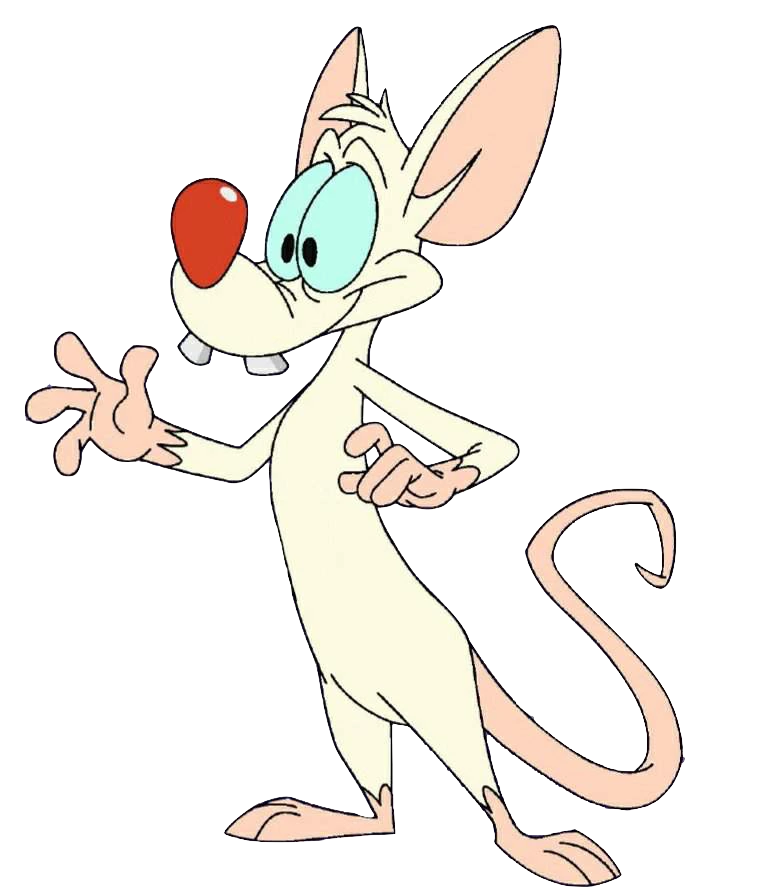
Pinky is actually a genetically engineered mouse that lives in the same Acme Labs cage as Brain. Pinky is a highly volatile and energetic mouse. He has various vocal tics, including “Zort,” “Narf,” “Troz,” and “Poit,” the latter of which he began speaking after observing “Zort” mirrored incorrectly in a mirror.
Pinky’s look contrasts with that of Brain: whereas Brain is small, has a crooked tail, and pink-colored sclera, and communicates in a deeper, more articulate way, Pinky has a very straight tail, blue-colored sclera, and an extreme overbite, is bigger than Brain, and talks in a very high-pitched tone with a Scouse British accent.
Pinky’s name was given to him accidentally by Brain: when speaking to himself, Brain insulted the two researchers responsible for his gene splicing, claiming they had less wisdom in both their brains than he had in his pinky! Pinky then said, “Yes?” thinking Brain was addressing him.
Pinky is much more open-minded, compassionate, and cheerful than the grumpy Brain. Troubles never mar his day, which might be because he is much too scatterbrained to notice them. He consistently assists Brain in his quest for world dominance, despite the fact that Brain frequently berates, belittles, and even assaults him. Pinky seemed to love it, frequently giggling after being smacked on the head.
He is preoccupied with trivia, investing a great deal of time in the lab watching television and keeping up with popular cultural fads. Pinky occasionally comes up with irrational answers to issues. An entire episode, which is titled “The Pinky P.O.V.” even depicts a typical evening of attempted world dominance from his point of view, demonstrating his thinking patterns and how he arrives at the strange, seemingly illogical answers to Brain’s famous conundrum, if Pinky is pondering about what he is pondering. Pinky frequently points out problems in the Brain’s schemes, which the Brain ignores. Pinky’s concerns may, ironically, contribute to the failure of the scheme in the particular night’s storyline.
He also is Brain’s sense of morality and real buddy. Pinky made a pledge for his soul to the devil in the episode “A Pinky and the Brain Halloween” to give Brain the world, but Brain rescued him since he wanted him around and the world was not worth governing without him. Pinky, despite his alleged idiocy, has also demonstrated intellect. In the episode “Welcome to the Jungle,” he used his instincts to survive and become a commander to Brain, who, in spite of his brilliance, could not live in the jungle on his own.
Once Pinky became the president in “The Pink Candidate”, he later began invoking numerous constitutional changes and legal issues that would prevent Brain from carrying out his newest scheme to take over the globe. When Brain attempted to pressure him into helping, Pinky refused, claiming that the plan “went against everything he had ever stood for.”
The Brain
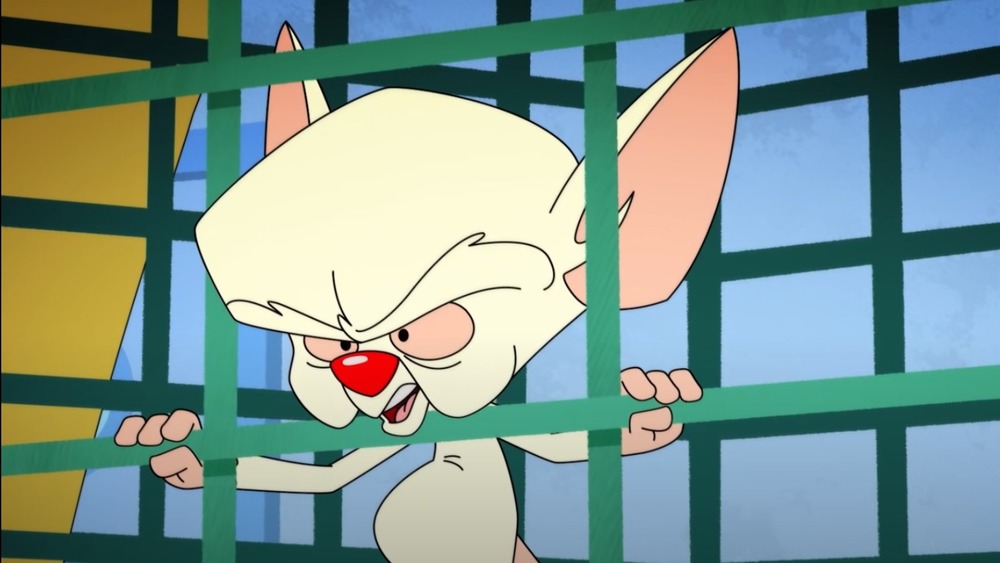
The Brain, or simply “Brain,” resembles and talks like Orson Welles. In the episode “What Ever Happened to Baby Brain?”, Brain runs into Welles, who now is employed as a janitor in a Hollywood eatery, and they mistakenly exclaim together that things will be different when they take over the planet. Brain’s moniker is the acronym for the titular program under “Project B.R.A.I.N.”: which is Biological Recombinant Algorithmic Intelligence Nexus.”
His tail, unlike Pinky, is angular and twisted, and he frequently uses it to open the lock on the cage door. His head is huge and broad, and it houses an exceptionally enormous brain. He is extremely brilliant and devises sophisticated schemes for world dominance that involve politics, cultural allusions and his own creations. He appears cold and emotionless, speaking in a snide deadpan tone.
Despite this, Brain has a delicate sense of wit and has even been in love, first with Trudie in “The Third Mouse” and then with Billie in the episode “The World Can Wait.” Brain has also been contrasted to Don Quixote and even has been described as a pop culture image of Napoleon Bonaparte due to his size and megalomania.
Brain views his inevitable climb to power as beneficial to the planet rather than just megalomania. He told Pinky in the Animaniacs segment, Wakko’s Wish, that they were on their way to fame, money, and a planet that was a better place for everybody. Several of the Brain’s machinations have the final goal of gaining a place in the hearts of people and then getting them to elect him as their king.
His motivations, however, are not pure. In one segment, Brain gets hypnotized by a doctor he had planned to use in one of his plots, who reveals himself to be none other than the famous Sigmund Freud. Brain confesses that he used to live in a tin can located at the bottom of a tree in a big field with his parents. When Brain was younger, ACME researchers kidnapped him and whisked him away from his home; the last thing he saw was an image of the globe on the wall of the container.
Dr. Freud suggests that Brain’s desire to rule the world is misdirected, and that what he truly desires is to return home to his family. According to the authors, Brain wishes to rule over the world, not to be a dictator like his competitor Snowball, but rather because he feels he can do a better job than the people in control.
Brain has even contributed to the planet’s salvation by doing all in his ability to halt Snowball’s terrible ambitions, understanding that a world ruled by Snowball would be the worst-case scenario. Throughout the 2020 Animaniacs revival, Brain faces a new foe in the shape of his wife, who is named Senator Julia Brain, following his efforts to mind-control her into becoming a puppet dictator for him, resulting in her becoming completely insane.
Snowball the hamster
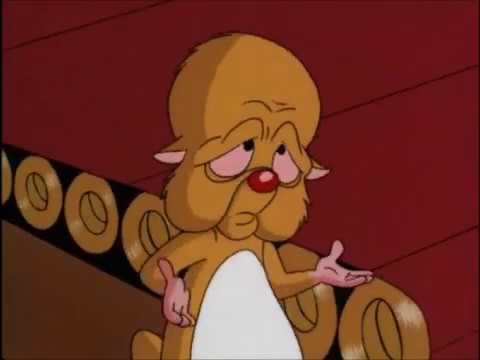
He is Brain’s old childhood friend-turned-rival, who, like Brain, was rendered smart by genetic manipulation and has a similar ambition for global conquest, albeit his motivation is considerably more malicious than Brain’s, which Pinky and Brain are often compelled to put a stop to.
Billie
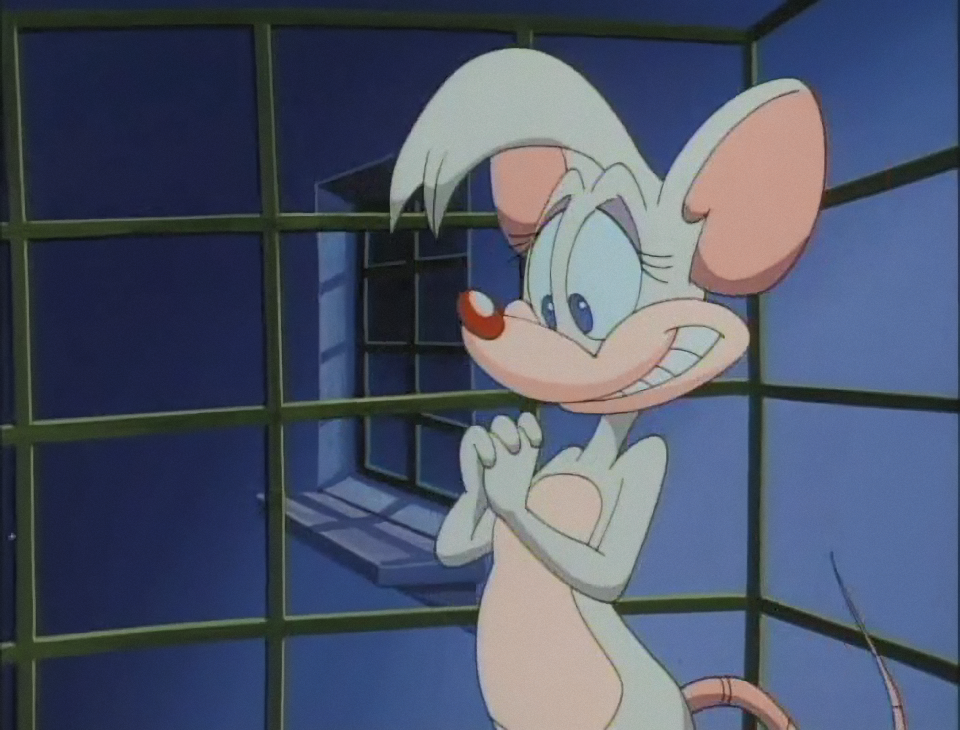
She is a white-colored female mouse and yet another consequence of gene splicing. She is sharper than Brain and she also desires world dominance. Though Brain adores her, Pinky is her favorite. In the show’s segment “You’ll Never Eat Food Pellets In This Town Again!”, it is disclosed that Brain is actually married to Billie, who in real life is named Sheila and despises playing Billie, and who agreed to tie the knot with him only due to the fact that he is famous, and ultimately kicks him out and forces him to live in his restaurant. It is eventually discovered that the incidents were all a dream.
Pharfignewton
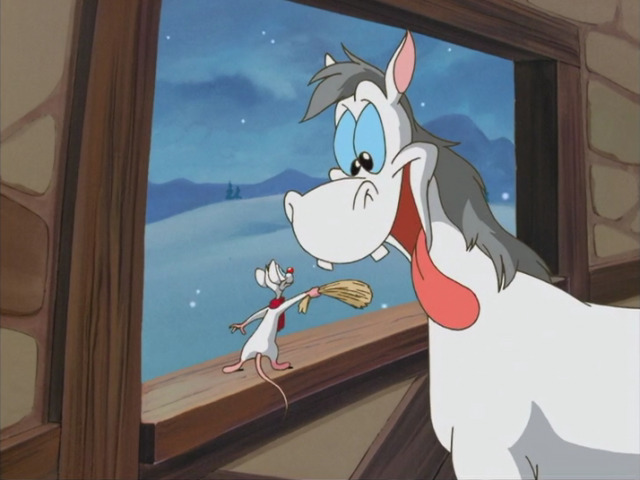
Pinky falls head over heels in love with her, a white race mare. Pinky refuses to heed to Brain’s continuous reminders that he is a rodent and that Pharfignewton is actually a horse.
Larry
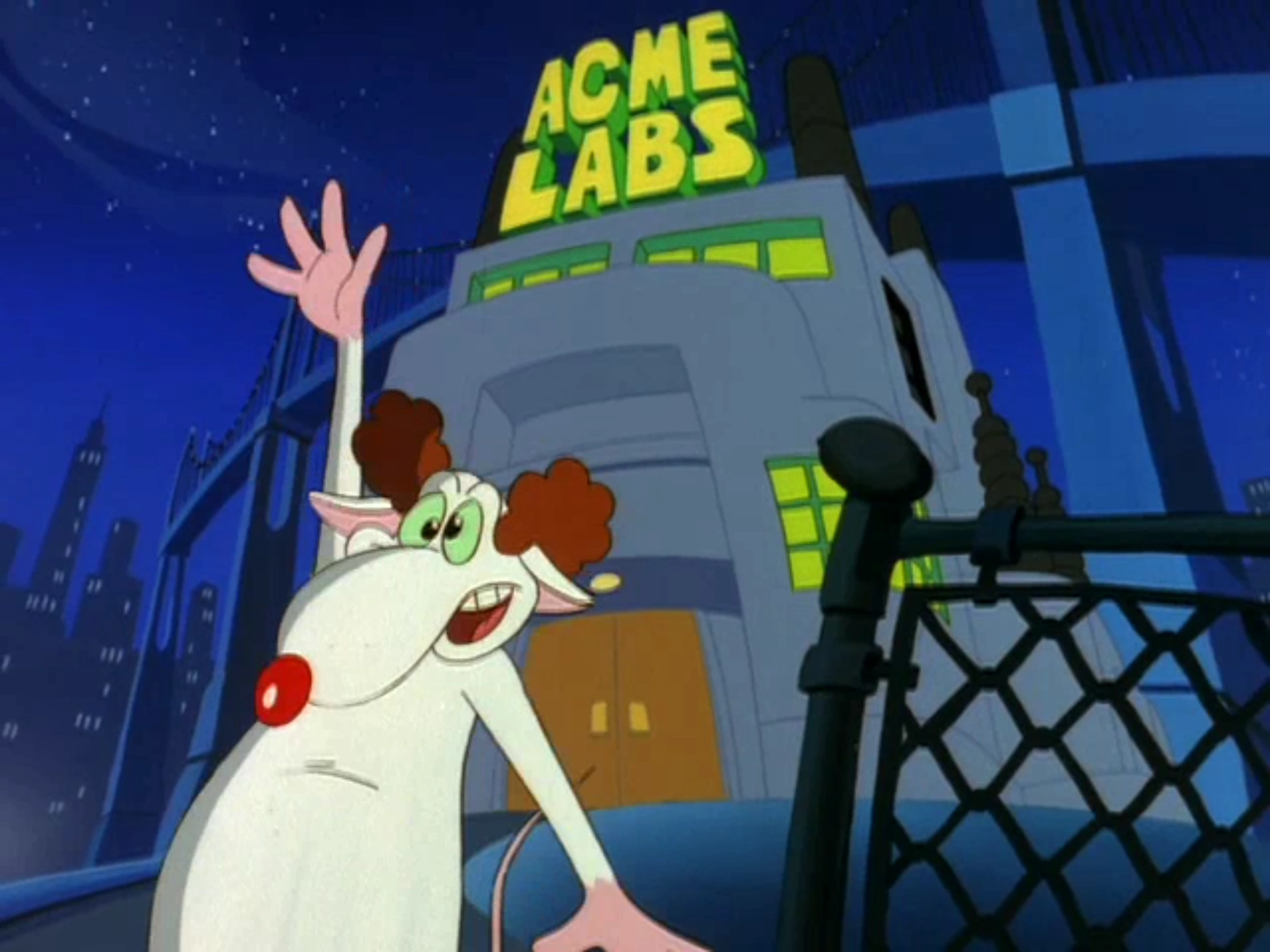
He is a white-colored mouse who was developed in response to Kids’ WB executives’ requests for more characters in the series. His appearance is infrequent because the show’s creators thought that adding another character would break the synergy between Pinky and Brain, who performed best as a comedic pair; hence, a third figure would be out of sync and unneeded in the storyline.
To further prove this point to everyone, Larry’s very first debut in the show was depicted by a slightly changed version of the original theme song with the phrase “and Larry!” sandwiched in between the existing lyrics. Because he is a spoof of Larry Fine who is from The Three Stooges, the segment is named “Pinky and the Brain…and Larry.”
Other characters on the show have featured both of Pinky’s and Brain’s parents, as well as the duo’s “son”, “Roman Numeral I” or Romy for short, another white colored mouse who was the product of a cloning error. Caricatures of celebrities appear in different episodes, including Hillary and Bill Clinton, David Letterman, Drew Carey, Dick Clark, Ryan Stiles, Michael Keaton, Kathy Kinney, Annabelle Gurwitch, J. D. Wilkes, Don Rickles, Donny and Eric from Too Something, Paul Gilmartin, “Macho Man” Randy Savage, The Allman Brothers Band, Jack Black, Chris Shiflett, David Cross, Christopher Walken, and Jim Nabors as Gomer Pyle, which was not unusual even in case of other Animaniacs programs.
Pinky and the Brain’s debut episode was titled “Das Brain”. In this episode, Brain has managed to free himself and Pinky from the mouse prison. His most recent scheme entails taking a mind-control narcotic found in the mucilaginous coating of a rare frog, which also happens to be in the lab and mind-controlling a large group of people by serving the narcotic as component of a pancake fest.
Brain would then use his recently acquired servants to enslave others, thereby gaining control of the world. However, two issues emerge. The first one is that the mind-control medication has a highly bitter taste, making the pancakes extremely unpleasant. The second problem is that Brain requires one more component for his mind-control drug: the flesh of a rare white crab that can only be found in one location: the dilapidated remains of the RMS Titanic. Pinky and the Brain then grab a submarine from inside the Woods Hole Oceanographic Institute before heading to the wreck to raise it in order to recover the crabs.
Brain could only turn the submarine slightly to the right since there is an anti-theft mechanism on the steering wheel. As a result, instead of the fast, straight-ahead route he had planned, he must follow a broad circular path that will take him significantly longer. Brain’s scheme fails despite their efforts, since Pinky removed the mind-controlling narcotic from the pancake batter to improve the taste. The episode concludes with Brain returning to the cell to plan his next plot.
“Of Mouse and Man” is the name of the second episode of Pinky and the Brain’s first season. Brain’s next plan for world dominance is to lock the whole telephone system in an unending voicemail loop, keeping everyone on the line and preoccupied while he takes control. However, he needed the unusually exact figure of $1,614,000 to do so. How would you obtain all of that money?
A sleazy lawyer’s ad persuades Brain that the best course of action is to acquire a job, manufacture a working injury, and afterwards sue his company for workers’ compensation. Brain finds a job at an unethical “re-re-insurance” firm while wearing his human costume. His boss’s lingering suspicions about his CV and a probable sexual harassment suit complicate his strategy, but Brain eventually fakes his injuries, and a tense trial starts.
This is the first segment in which Brain pretends to be a human by wearing a human costume. The humor in this is that the suit is both super-strong and difficult to control, resulting in things like Brain crushing his boss’s table when shaking hands. However, Brain makes no effort to conceal his head, resulting in the bizarre image of a little mouse head poking out of a humanoid torso.
When Brain’s new employer hires him, he drops off a handful of one-page paperwork outlining company standards, then dumps a massive stack of paper which is the company’s sexual harassment policy. Brain later gets into some scrapes and difficulties when his faulty human suit causes him to manhandle his gorgeous colleague mistakenly. Pinky appears in the human costume just as Brain’s litigation plot fails and he is jailed for lying. Unfortunately, he ends up treading on Brain during the process.
In the episode Tokyo Grows, the Brain planned to utilize a “growing ray” to expand Pinky to become super-size while costumed as Gollyzilla, a spoof of Godzilla, while Brain will stop him in return for global dominance. Eventually, the real Godzilla rises from the sea and begins to rampage, leading Brain to believe that the real Godzilla is actually Pinky.
The episode concludes with the beam expanding everything on Earth, along with the Earth, to the point where the Brain, Pinky and even Godzilla are again mouse-sized in contrast. The title of the piece is a play on Tokyo Rose, the term coined by the Allies to every female English-speaking Japanese propagandist broadcaster during WWII.
Brain creates a contraption that can raise or reduce intelligence in the episode “The Smarts” so that Pinky could become intelligent enough to comprehend that he is the source of Brain’s failures. Pinky, who is upset because Brain does not like him while he is clever, uses the device to make himself dumber so that Brain may like him again. However, Brain, seeing that he is the source of his failings and assuming that both of them would be better off having Pinky as the scholar and Brain as the fool, uses the device on himself as well. Finally, both of them turn into fools who are too stupid to run the machine and return either of them to the smart selves.
Finally, “Brainstem,” which is about two minutes in length, is merely a track in which the Brain and Pinky sing about the human mind and its many sections. The ending line of The Brain relates to an urban legend involving a children’s show host who allegedly finished one broadcast shouting something obscene without knowing he was still on air.
Cartoon Casts
Rob Paulsen as Pinky
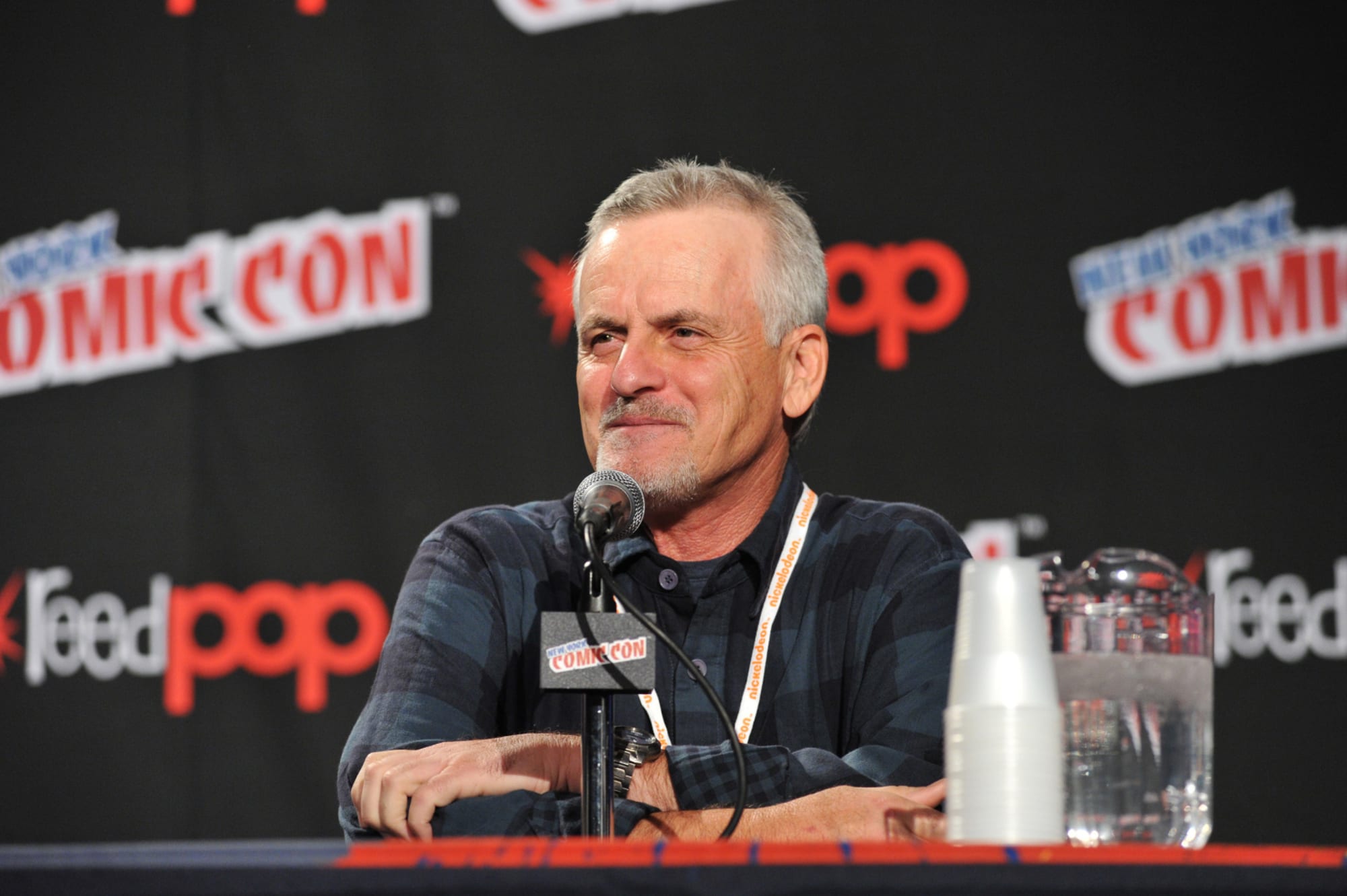
Robert Frederick Paulsen III, born 11th March 1956, is a voice actor from the United States. Paulsen has provided the voice for over 250 distinct cartoon characters and over 1,000 commercials. For his portrayal as Pinky, he got a Daytime Emmy Award as Outstanding Performer in a Cartoon Program, while he also has three Annie Awards under his belt.
Maurice LaMarche as The Brain
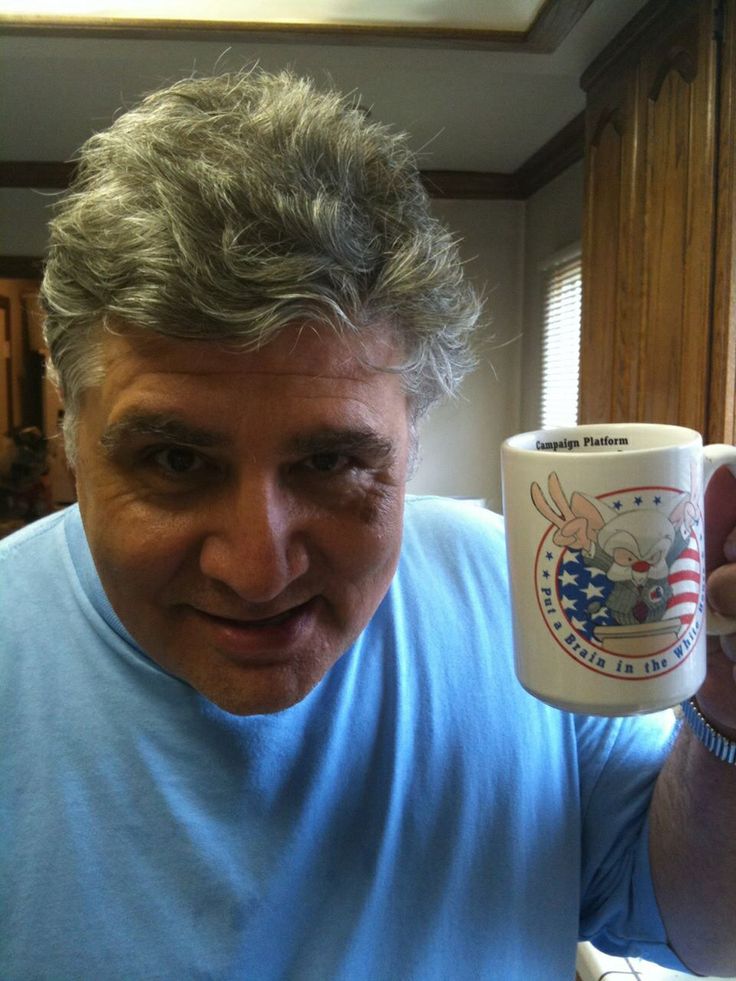
Maurice LaMarche, born on 30th March 1958, is a voice actor, comic, and impressionist from Canada. He played the Brain in both Animaniacs and its original program Pinky and the Brain. Linda Bourdon and Guy LaMarche gave birth to Maurice in Toronto, Canada. Soon after his birth, his family relocated to Timmins, Ontario. LaMarche grew up in his own little universe of animations and sixties television. He discovered the popularity his knack for mimicking might bring him when he was in his 2nd year of high school.
Roddy McDowall as Snowball

Roderick Andrew Anthony Jude McDowall was a British actor, movie director, and photographer who was born on 17th September in 1928 and passed away on October 3, 1998. He began his performing career as a kid in England, then in America. McDowall worked as a leading man on radio, theater, cinema, and television as an adult. Following the onset of World War II, McDowall’s family relocated to the United States of America in 1940. On 9th December in 1949, he was naturalized as a US citizen.
Interesting Facts About The Show
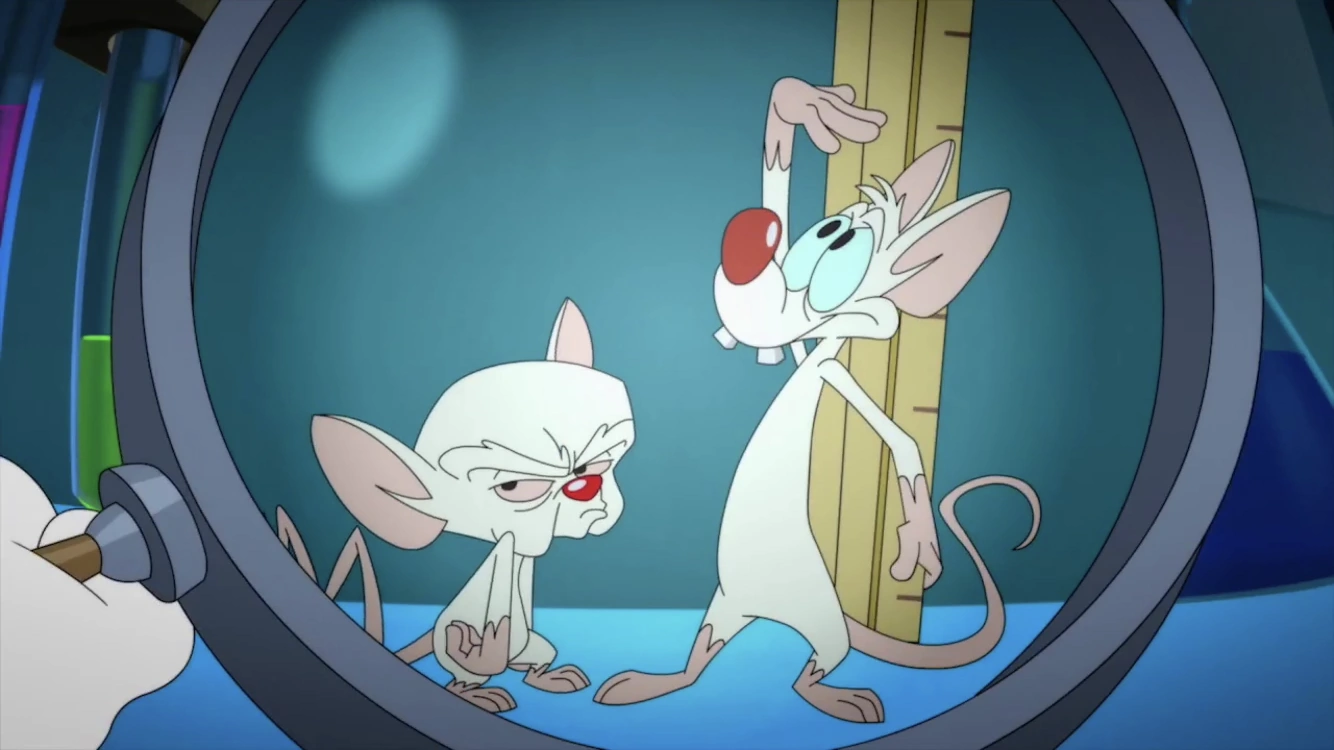
Eddie Fitzgerald, Tiny Toon Adventures creator and animator, was fond of saying “narf”, “egad”, and “poit”, but his “narf” sounded more like “nerf.” The Brain reminds us of Animaniacs writer and producer Tom Minton and is most likely a caricature of him. Rob Paulsen, who voiced Pinky, was the original voice of Raphael on Teenage Mutant Ninja Turtles and also Yakko on Animaniacs. Maurice LaMarche previously played Chief Quimby on the show Inspector Gadget, and also played George Wilson and Henry Mitchell on the program Dennis the Menace, as well as Destro on the show G.I. Joe.
Paulsen was a Monty Python aficionado and rightly predicted that the makers of Pinky and the Brain, especially executive producer Steven Spielberg, would appreciate “that English thing” for the character. In the briefly running cartoon inspired by the cult film, LaMarche portrayed Zoltan and also Tomato Guy, which he had never even seen. Mummato and also Tomato Worm were both voiced by Paulsen. According to LaMarche, his tone for The Brain is actually 20 percent Vincent Price and 70 percent Welles.
LaMarche was originally handed a cassette of Welles fighting with one of the recording engineers in the 1980s as a prize for skipping a great New Year’s Eve celebration in order to complete a grueling day of voice acting. As a component of his vocal warm-ups, the actor heard it continuously, eventually memorizing it and repeating Welles’ rants. As was the situation with all Warner Bros. cartoons during the 1990s. The words for the theme song were penned by the creator of the show, Tom Ruegger, and the melody was produced by Richard Stone, who is widely regarded as the modern-day successor to Carl Stalling, who created the soundtracks for Warner’s short films for more than 20 years. Stone died of pancreatic cancer in 2001, aged 47.
The WB’s network management wanted the program to turn into more of an ensemble show, similar to The Simpsons, in 1998. The two rodents were recruited by Elmyra Duff from Tiny Toon Adventures and were tentatively named the Further Adventures of Pinky & The Brain. It only lasted 13 episodes. Brain gets the adverse effects of smoking after volunteering as a test rat for a tobacco firm in the episode “Inherit the Wheeze.” The program received a PRISM Award from the Entertainment Industries Council for accurately portraying the consequences of drug, alcohol, and cigarette usage.
Brain is writing a difficult formula regarding the Universe Explained, which was simplified, in the opening titles, and the final solution is THX 1138 with the year 1971, which is the name of George Lucas’ debut film. Snowball, Brain’s adversary, was nicknamed after a figure in George Orwell’s famous “Animal Farm”. Bruce Timm accidently conceived the ideas of the Brain and Pinky while drawing cartoons of producers Tom Minton and Eddie Fitzgerald.
Cancellation of the show
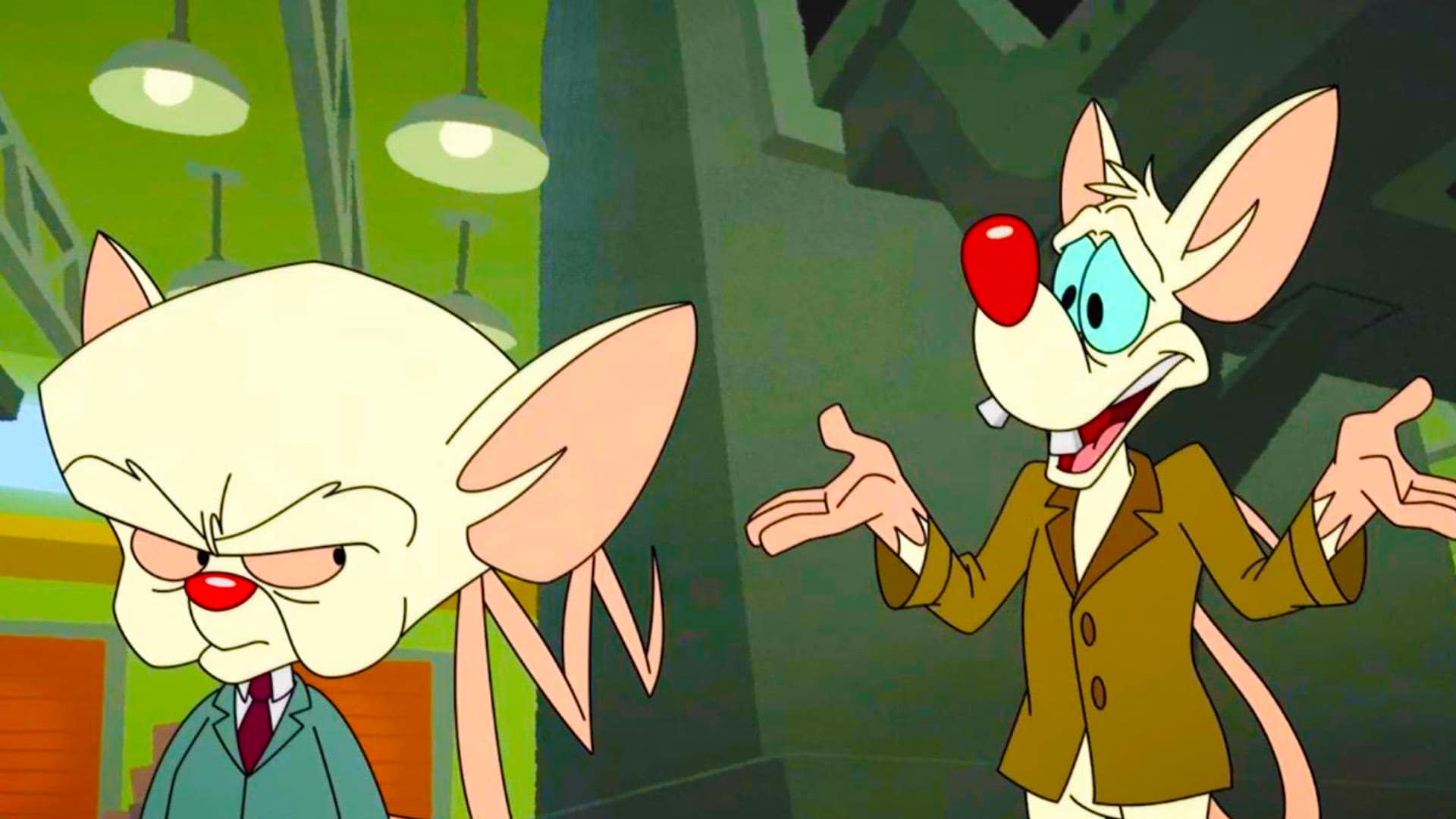
The Brain’s voice actor, Maurice LaMarche, told Uproxx that the show was envisioned as more or less The WB’s equivalent to The Simpsons. However, apart from its basic scheduling flaws, Pinky and the Brain did not fit the form of a classic sitcom. This caused a lot of friction between both the creative department and the broadcasting network. The characters were terrific, but WB execs could not get into the “global takeover” idea and kept pressing the production to bring in additional actors and make it much more sitcom-y.
For the majority of the show’s life, this resulted in persistent opposition against forced retooling. The segment “Pinky and the Brain… and Larry” mocked the notion of introducing additional characters for no apparent reason by demonstrating how a third mouse styled after Larry Fine, who was from The Three Stooges, would disrupt the chemistry. Pinky and the Brain were subjected to awful presentations for new schemes in “Brain Drained”, whereas “You’ll Never Eat Food Pellets in This Town Again”, which was the final episode written and produced by Peter Hastings before he left, explicitly criticized The WB’s leadership.
In the end, the demands of the network prevailed. Pinky and the Brain got reworked as Pinky, Emyra, and the Brain in 1998, the very same year Animaniacs got terminated. Acme Labs was demolished, and the Brain and Pinky became the pets of Tiny Toon Adventures’ cloying Elmyra Duff. Plots about world dominance fell in lieu of more typical suburban-sitcom shenanigans. The title song alone made it apparent that everyone involved in the program despised it.
Viewers disliked it as well, with just five of the thirteen produced episodes obtaining a regular broadcast while the others were subsequently screened as part of an anthology program named The Cat & Birdy. Pinky Brainy Warneroonie Big Cartoonie Show. That marked the end of a two-decade cooperation involving Steven Spielberg and Warner Bros. Animation. With Kids’ WB enjoying greater success than ever before with lower-cost purchases such as Pokemon, it also marked the end of the platform’s considerable expenditures in original comedic cartoons.
The classic Pinky and the Brain program warranted so much better, but it has become somewhat of a contemporary classic in the decades after its awful retooling and discontinuation. We can only hope that the duo’s return to Hulu is a pleasant return to form.
